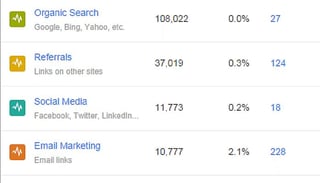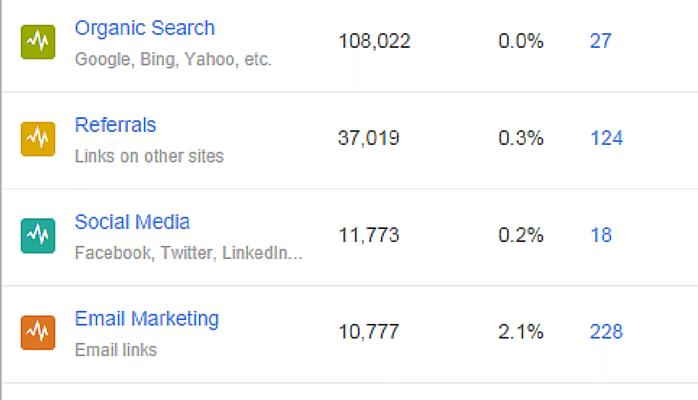
This was originally published on LinkedIn's Pulse
Sometimes you don't even know what you don't know
How do you know if your website is really performing? Do you measure online marketing success by phone calls or keyword rankings? Do you track traffic or leads? If you're not sure exactly what key performance indicators (K.P.I.) to track or where to find the data you're looking for I have some ideas to lend a hand.
The 5 most important online metrics to track
#1 - Is your traffic growing?
It all starts with traffic coming to your website, without people on your site they certainly won't buy from you. You should be tracking your traffic with software like Google Analytics (G.A.). G.A. can help you analyze your traffic data in a lot of different ways but what you should really be looking for is trends.
Sometimes seasonality and holidays can really skew the data, your best bet is to compare year-over-year, period-over-period. You want to know that your traffic is steadily growing over those parameters. One of the worst things you can do is over-react to short-term trending with partial information and make the wrong move trying to fix a problem that isn't there.
#2 - Where is your traffic coming from?
You should be keeping an eye on your keywords to make sure they're progressing but search engine traffic shouldn't be your only source of traffic to your website. You should be monitoring traffic from the following sources:
- Referral - other sites that link to your site, their visitors click through
- Email - a great method for marketing to your existing contacts, good content and resources that answer their questions with links back to your website should be a consistent source of traffic
- Social - if you're linking resources from your blog and website in social posts you'll drive new visitors to your site
- Direct - people who know or discover you from offline settings will enter your name directly into browsers, creating a large amount of your traffic
- Organic - the more keywords and phrases you rank for (and the more times their searched), the more often you'll be found on Google, Yahoo, or Bing. Take care to follow the rules of the game, cheaters don't win.
#3 - Is your traffic converting?
While you're monitoring traffic growth and sources you'll also want to monitor the percentage of that traffic that is converting into leads. That usually consists of a lead completing a simple form to either sign up for resources, download information, or ask a question.
Average conversion rates vary by industry, according to a recent article by Marketing Sherpa. Regardless of your industry, you should be maximizing your conversion opportunities and tracking to ensure rates are increasing or maintaining healthy rates based on industry standards.
To maximize lead conversions you need a few things to align:
- Your website needs to view well on all device types, not just computer monitors but smart phones and tablets. test your site's responsiveness
- Your website needs to contain valuable, downloadable resources and information that is gated behind landing pages and accessed by forms
- Your website needs to advertise these resources with clear calls-to-action (C.T.A.)
#4 - Are your leads being nurtured?
Websites that capture contact information are great, but it's what you do with that information that matters. Once you've built the inbound lead funnel you'll want to pay special attention to lead nurturing. Nurturing your leads consists of a timed follow up procedure that offers additional information and tools. The goal should be to help leads find what they're looking for as they go through different stages of the buying cycle.
94 percent of B2B buyers research online for purchase decisions - Brafton
Because more and more prospects are doing their research online, it's important to position yourself as their ally in the process. Those who serve as a resource to information-seeking prospects allow themselves the opportunity to present solutions at a later stage in the cycle.
#5 - Are any leads turning into customers?
As your suspects become prospects you'll need a plan to hand off effectively to your sales team. It's critically important that your sales team understand two things:
- Leads that came through your website need to be handled different than traditional lead sources.
- Understanding the intelligence provided will be critical to their success.
Sales people are pretty stubborn, and pretty proud of themselves. As the self-proclaimed upper class of your organization it can be difficult for them to change their habits and approach. Sales staff need to understand that we're living in the Age of The Customer, and that they're not nearly as vital to the sale as they used to be. That said, they do play the most critical role so they'll still be able to pat themselves on the back and take credit for the sale.
To ensure your sales staff doesn't destroy the opportunities they're passed from your online lead generation efforts, have them follow these steps:
- Review the source - how did they end up on the website?
- Review their interaction - what emails did they open and what content did they consume?
- Interaction habits - is there a commonality in the times of day or days of the week that they interacted with your communication?
- Exploratory call scripting - their first call needs position them as a trusted resource reaching out to help them complete their education
If you're able to track conversion rate over all five of these steps you'll be well on your way. You'll then be able to build goals around rates of desired conversion for each step and measure against them regularly. The result will be a much better understanding of what's working, what's not, and where you need to focus additional time or resources to drive your business forward.
Or, learn how we can jump start your digital marketing efforts.

